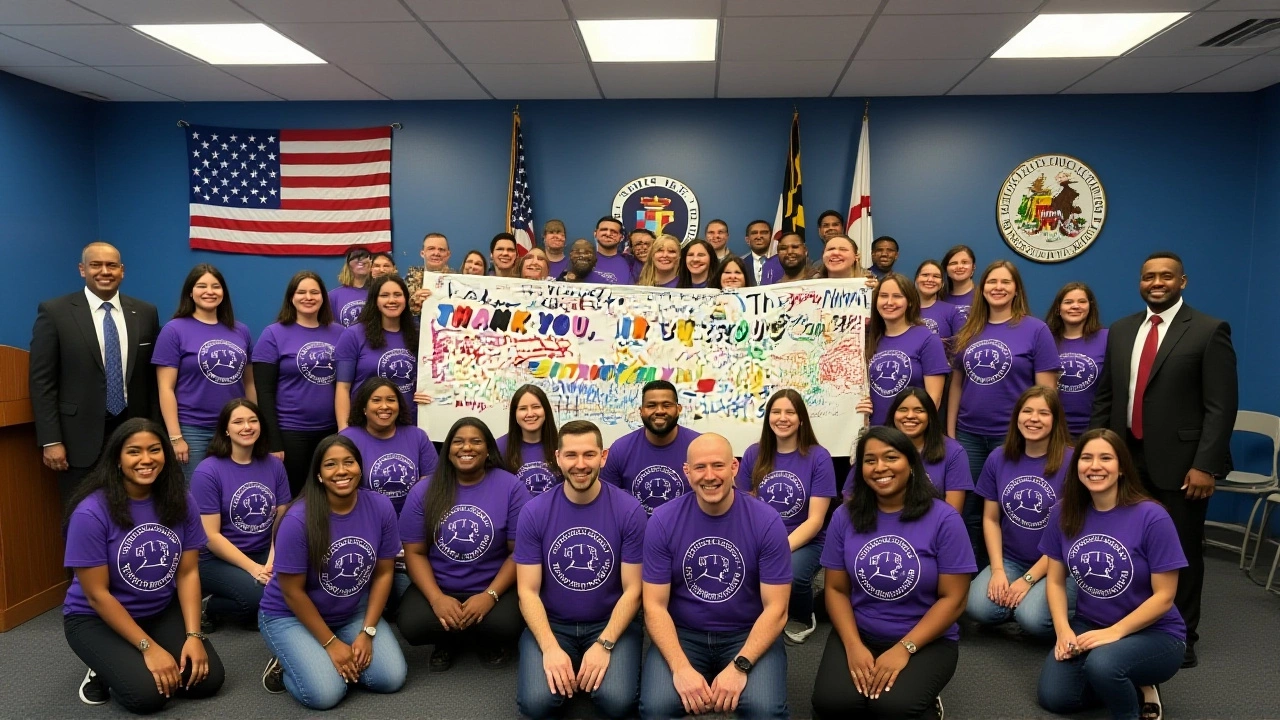On November 17, 2025, the Prince George's County Council voted to dismantle a decades-old policy that had treated pit bulls as public threats — not pets. The council passed Bill #25-0473, known as the Animal Control Modernization ActPrince George's County, Maryland, effectively ending a 29-year ban on pit bull-type dogs. The law, which took effect immediately, doesn’t just remove restrictions — it replaces them with a structured, behavior-based system. For the first time since 1996, residents can legally own, adopt, or foster these dogs — if they meet new requirements. And it’s already changing lives. That same day, a pit bull terrier mix named Renee walked out of the Prince George's County Animal Shelter in Upper Marlboro, headed not to euthanasia, but to a foster home in Anne Arundel County. "She might be one of the last pit bulls that needs to be moved," said a volunteer with Friends of Prince George's Animals. And for the first time in years, that sentence felt hopeful.
Why This Ban Existed — And Why It Failed
The ban began in 1996, after a highly publicized fatal dog attack in Baltimore City on July 12, 1995. Panic spread. Lawmakers across Maryland rushed to pass breed-specific laws. But by 2000, the Centers for Disease Control and Prevention had released findings showing breed-specific legislation didn’t reduce dog bites. Other Maryland counties — Montgomery County, Howard County, even Baltimore City — repealed their bans between 2000 and 2015. Only Prince George’s held on. Why? Tradition. Fear. A stubborn belief that certain looks equal danger.Here’s the twist: pit bulls aren’t even a single breed. The law defined them as American Pit Bull Terriers, American Staffordshire Terriers, Staffordshire Bull Terriers — or any mix with broad heads, muscular builds, and short coats. A 2024 study from the University of Maryland College Park’s Department of Animal Sciences found that 92.7% of dogs labeled "pit bulls" in shelters were actually mixed breeds with no true lineage to those breeds. They were just… big. Muscular. Misunderstood.
The New Rules: Permits, Insurance, and Training
This isn’t a free-for-all. The Animal Control Modernization Act introduces a pilot program with real guardrails. Starting December 1, 2025, owners must apply for a special permit through the Prince George's County Animal Control office at 6500 Old Muirkirk Road in Beltsville. No permit? No dog. Simple as that.Here’s what’s required:
- At least $100,000 in liability insurance
- Completion of a certified handler training course
- Secure, fenced enclosures meeting county standards
- Leashes no longer than six feet in all public spaces
Fines for violations? They’re going up — way up. The old $100 maximum is gone. Exact penalties are still being drafted, but council members hinted they’ll be "meaningful enough to deter negligence." Inspections happen within 14 days of application. And quarterly reports to the council will run through December 2026, when lawmakers will decide whether to make the program permanent.
The Advocates Behind the Change
This wasn’t sudden. It was the result of six years of relentless organizing by Ban the Ban PG, a coalition co-founded in 2019 by Sarah Chen, a certified dog trainer from Hyattsville, and Marcus Johnson, a veterinarian from Bowie. They collected 14,250 petition signatures. They hosted town halls. They brought shelter dogs to council meetings. They showed up — every time."We weren’t asking for special treatment," Chen told WYPR and The Baltimore Banner in a joint interview. "We were asking for fairness. These dogs are loved. They’re family. They’re not statistics."
And the numbers backed them up. In fiscal year 2025 alone, Friends of Prince George's Animals relocated 278 pit bull-type dogs from the county shelter — most to foster homes or rescue groups outside the county. On the day the ban ended, 13 dogs were moved. One of them was Renee. The next day? Zero.

What This Means for the Community
Prince George’s County is home to nearly 967,000 people. For decades, families who owned pit bull mixes lived in fear — of fines, of confiscation, of losing their pets overnight. Now, they can breathe. But the shift isn’t just emotional. It’s practical. The county’s animal control system spent hundreds of thousands of dollars annually housing, transporting, and euthanizing dogs based on appearance, not behavior. That money can now go toward training, education, and community outreach."This is about responsibility, not fear," said Marcus Johnson at the council meeting. "A dog that bites is a bad dog. Not a bad breed."
And the data supports it. A 2023 study from the American Veterinary Medical Association found that breed-neutral laws — focusing on owner accountability, leash enforcement, and early intervention — reduced dog bites by 31% over five years in comparable counties. Prince George’s is betting on that model now.
What Comes Next?
The pilot program runs through December 2026. If it succeeds — meaning fewer incidents, more adoptions, higher compliance — the ban will be permanently repealed. If it fails? The council could revert to restrictions. But the momentum is irreversible. The shelter’s intake of pit bull-type dogs has already dropped by 40% since the bill passed, as owners rush to register before inspections begin. Foster families are lining up. Rescues are celebrating.And Renee? She’s now living with a family in Anne Arundel County. Her new owner says she’s the sweetest dog they’ve ever had. She loves kids. She naps on the couch. She doesn’t bite. She just… exists. Quietly. Happily. Finally, legally.
Frequently Asked Questions
How does this affect pet owners in Prince George’s County?
Owners of pit bull-type dogs must now obtain a permit from the Prince George's County Animal Control division, complete a certified training course, carry $100,000 in liability insurance, and keep dogs on six-foot leashes in public. Failure to comply results in significantly higher fines than before — though exact amounts are still being finalized. The change removes the threat of automatic euthanasia or forced relocation based solely on breed appearance.
What defines a "pit bull" under the new law?
The law defines pit bull-type dogs as American Pit Bull Terriers, American Staffordshire Terriers, Staffordshire Bull Terriers, or any mixed breed exhibiting physical traits like a broad head, muscular build, and short coat. Importantly, the American Kennel Club doesn’t recognize "pit bull" as a breed — it’s a descriptor. A 2024 University of Maryland study found 92.7% of dogs labeled "pit bulls" in shelters were actually mixed breeds without pure lineage to those breeds.
Why did Prince George’s County hold on to the ban longer than others?
After the 1995 fatal attack in Baltimore City, many Maryland jurisdictions enacted breed-specific bans. But by 2015, every other county and Baltimore City repealed theirs after CDC data showed such laws didn’t reduce bites. Prince George’s held on due to political inertia and lingering public fear — despite mounting scientific evidence against breed-specific legislation. Advocates spent six years changing that narrative.
How many dogs were affected by the old ban?
Approximately 300–400 pit bull-type dogs entered the Prince George's County Animal Shelter each year under the old policy. Most were either euthanized or relocated. In fiscal year 2025 alone, the nonprofit Friends of Prince George's Animals facilitated 278 relocations. On the day the ban ended, 13 dogs were moved — one of them, Renee, became a symbol of the shift.
Is this change permanent?
Not yet. The law creates a pilot program running through December 2026. The Prince George's County Department of Health must submit quarterly progress reports to the council. Based on data — including bite incidents, permit compliance, and adoption rates — the council will decide whether to make the program permanent. Early signs are positive: shelter intake has dropped 40% since the bill passed.
Who pushed for this change, and how?
The coalition Ban the Ban PG, founded in 2019 by Hyattsville dog trainer Sarah Chen and Bowie veterinarian Marcus Johnson, led the effort. They gathered 14,250 petition signatures, commissioned a University of Maryland study debunking breed stereotypes, and testified at every council meeting for six years. Their work transformed public perception — from fear to fact-based policy.
